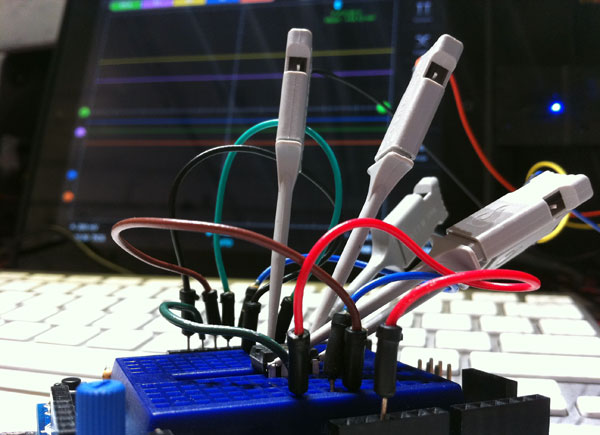Entries tagged as hardware
Related tags
3d camera flash game headset history mobile mobile phone software technology tracking virtual reality web wiki www 3d printing 3d scanner crowd-sourcing diy evolution facial copy food innovation&society medecin microsoft physical computing piracy programming rapid prototyping recycling robot virus ad android ai algorythm apple arduino automation data mining data visualisation network neural network sensors siri amd cpu intel qualcomm app google htc ios linux os sdk super collider tablet usb api facial recognition glass interface mirror amazon cloud iphone ar augmented reality satellite army drone artificial intelligence big data car cloud computing privacy program super computer asus kinect light wifi chrome browser firefox ie laptop computing farm open source security sustainabilityThursday, July 14. 2011
Faster and stronger: next-generation memory tech outperforms flash
Via ars technica
-----

Flash memory is the dominant nonvolatile (retaining information when unpowered) memory thanks to its appearance in solid-state drives (SSDs) and USB flash drives. Despite its popularity, it has issues when feature sizes are scaled down to 30nm and below. In addition, flash has a finite number of write-erase cycles and slow write speeds (on the order of ms). Because of these shortcomings, researchers have been searching for a successor even as consumers snap up flash-based SSDs.
There are currently a variety of alternative technologies competing to replace silicon-based flash memory, such as phase-change RAM (PRAM), ferroelectric RAM (FERAM), magnetoresistive RAM (MRAM), and resistance-change RAM (RRAM). So far, though, these approaches fail to scale down to current process technologies well—either the switching mechanism or switching current perform poorly at the nanoscale. All of them, at least in their current state of development, also lack some commercially-important properties such as write-cycle endurance, long-term data retention, and fast switching speed. Fixing these issues will be a basic requirement for next-gen non-volatile memory.
Or, as an alternative, we might end up replacing this tech entirely. Researchers from Samsung and Sejong University in Korea have published a paper in Nature Materials that describes tanatalum oxide-based (TaOx) resistance-RAM (RRAM), which shows large improvements over current technology in nearly every respect.
RRAM devices work by applying a large enough voltage to switch material that normally acts as an insulator (high-resistance state) into a low-resistance state. In this case, the device is a sandwich structure with a TaO2-x base layer and a thinner Ta2O5-x insulating layer, surrounded by platinum (Pt) electrodes. This configuration, known as metal-insulator-base-metal (MIMB), starts as an insulator, but it can be switched to a low resistance, metal-metal (filament)-base-metal (MMBM) state.
The nature of the switching process is not well understood in this case, but the authors describe it as relying on the creation of conducting filaments that extend through the Ta2O5-x layer. These paths are created by applying sufficiently large voltages, which drive the movement of oxygen ions through a redox (reduction-oxidaton) process.
When in the MIMB state, the interface between the Pt electrode and the Ta2O5-x forms a metal-semiconductor junction known as a Schottky barrier, while the MMBM state forms an ohmic contact. The main difference between these two is that the current-voltage profile is linear and symmetric for ohmic but nonlinear and asymmetric for Schottky. The presence of Schottky barriers is a benefit, as it prevents stray current leakage through an array of multiple devices (important for high-density storage).
The results presented by the authors appear to blow other memory technologies out of the water, in pretty much every way we care about. The devices presented here are 30nm thick, and the switching current is 50 ?A—an order of magnitude smaller than that of PRAM. They also demonstrated an endurance of greater than 1012 switching cycles (higher than the previous best of 1010 and six orders of magnitude higher than that of flash memory at 104-106). The device has a switching time of 10ns, and a data retention time that's estimated to be 10 years operating at 85°C. This type of RRAM also appears to work without problems in a vacuum, unlike previously-demonstrated devices.
This may all seem too good to be true—it should be emphasized that this was only a laboratory-scale demonstration, with 64 devices in an array (therefore capable of storing only 64 bits). There will still be a few years of development needed before we see gigabyte-size drives based on this RRAM memory.
Like all semiconductor device fabrication, advances will be needed to improve nanoscale lithography techniques for large-scale manufacturing and, in this particular case, a better understanding of the basic switching mechanism is also needed. However, based on the results shown here, this new memory technology shows promise for use as a universal memory storage: the same type could be used for storage and working memory.
Monday, July 11. 2011
Toolbox Review: iMSO-104 Oscilloscope for iPad & iPhone
Via makezine
-----
Included tangibles are as follows:
- iMSO-104 Mixed Signal Oscilloscope Hardware
- 1x/10 Analog Probe
- Logic Harness (4 Digital + 1 Ground)
- SMD Grabbers (4 Digital + 1 Ground)
- Screwdriver for Analog Waveform Compensation Adjustment
- Analog tip covers (2 pieces)
The core hardware, based on the Cypress PSoC 3 chip, is housed in a slim enclosure with requisite Apple dock connector, SMB jack for the analog probe, and 5-pin male header to accommodate 4 digital channels + ground. The included set of probes appear well-built, and I estimate they’d withstand the level abuse my other test equipment is subject to. The unit also includes a small blue LED power indicator which turns off whenever the device’s related software becomes inactive.
Software
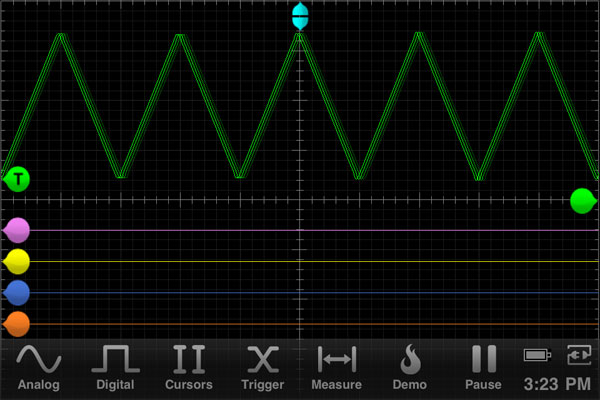
The iMSO’s software portion is available for free as a Universal app and includes an interactive demo mode to give you an idea of how the unit handles analog signals. The app implements standard digital scope functionality (zoom, trigger, cursor/measurement) with thankfully little UI clutter. In addition to standard menu controls, users can employ familiar pinch-to-zoom gestures as well as control voltage trigger level via onscreen sliders, and double-tap to toggle display infos.
Usage
Right off the bat, I was intrigued at the thought of using the iPad’s 9.7? display and touch input for highly portable ‘scoping. And yes, viewing a sinewave in such a manner does feel satisfyingly slick and moreover, imbues Apple’s hardware with an air of technical sophistication rarely achieved while editing a Pages document or playing Angry Birds. The iMSO software was easily controllable via my iPhone, but I really can’t imagine using it much on that platform when given the option of a much larger display.
While it won’t replace my big ol’ 50MHz CRT benchtop dinosaur, the iMSO’s comparatively humble 5MHz analog bandwidth works well for inspecting audio signals (which I do quite often). Additionally, max voltage limits on the devices inputs (±40V analog 10x, -0.5V/+13V digital) mean I’m likely to reserve use exclusively for low-power audio work. On the digital side, the unit did prove capable when I attempted peeking in on some serial communications between an Arduino board and MCP4921 DAC chip.
The fact that iOS devices use a single port for both power & data, means you’ll have to rely on battery power while using the iMSO. Thankfully, the device + software went easy on my iPad 2?s battery – so power is likely only a concern for those who plan on marathon testing/debugging sessions.
The ~$300 pricetag and bandwidth limitations will likely limit the iMSO’s initial audience – but if those points don’t pose a problem for you, well, this thing is pretty dang sweet. As the IMSO-104 is the first in its category, It will be interesting to see what future developments hold for iOS test equipment – see, we shall.
Thursday, July 07. 2011
Ambient electromagnetic energy harnessed for small electronic devices
Via Physorg
-----
Researchers have discovered a way to capture and harness energy transmitted by such sources as radio and television transmitters, cell phone networks and satellite communications systems. By scavenging this ambient energy from the air around us, the technique could provide a new way to power networks of wireless sensors, microprocessors and communications chips.
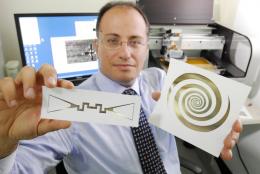
Georgia Tech School of Electrical and Computer Engineering professor Manos Tentzeris holds a sensor (left) and an ultra-broadband spiral antenna for wearable energy-scavenging applications. Both were printed on paper using inkjet technology.
"There is a large amount of electromagnetic energy all around us, but nobody has been able to tap into it," said Manos Tentzeris, a professor in the Georgia Tech School of Electrical and Computer Engineering who is leading the research. "We are using an ultra-wideband antenna that lets us exploit a variety of signals in different frequency ranges, giving us greatly increased power-gathering capability."
A presentation on this energy-scavenging technology was scheduled for delivery July 6 at the IEEE Antennas and Propagation Symposium in Spokane, Wash. The discovery is based on research supported by multiple sponsors, including the National Science Foundation, the Federal Highway Administration and Japan's New Energy and Industrial Technology Development Organization (NEDO).
Communications devices transmit energy in many different frequency ranges, or bands. The team's scavenging devices can capture this energy, convert it from AC to DC, and then store it in capacitors and batteries. The scavenging technology can take advantage presently of frequencies from FM radio to radar, a range spanning 100 megahertz (MHz) to 15 gigahertz (GHz) or higher.
Georgia Tech School of Electrical and Computer Engineering professor Manos Tentzeris displays an inkjet-printed rectifying antenna used to convert microwave energy to DC power. It was printed on flexible material. (Georgia Tech Photo: Gary Meek).

Georgia Tech School of Electrical and Computer Engineering professor Manos Tentzeris displays an inkjet-printed rectifying antenna used to convert microwave energy to DC power. It was printed on flexible material. (Georgia Tech Photo: Gary Meek).
Utilizing ambient electromagnetic energy could also provide a form of system backup. If a battery or a solar-collector/battery package failed completely, scavenged energy could allow the system to transmit a wireless distress signal while also potentially maintaining critical functionalities.
When Tentzeris and his research group began inkjet printing of antennas in 2006, the paper-based circuits only functioned at frequencies of 100 or 200 MHz, recalled Rushi Vyas, a graduate student who is working with Tentzeris and graduate student Vasileios Lakafosis on several projects.
"We can now print circuits that are capable of functioning at up to 15 GHz -- 60 GHz if we print on a polymer," Vyas said. "So we have seen a frequency operation improvement of two orders of magnitude."
The researchers believe that self-powered, wireless paper-based sensors will soon be widely available at very low cost. The resulting proliferation of autonomous, inexpensive sensors could be used for applications that include:
Wednesday, July 06. 2011
Afghan City Builds DIY Internet Out Of Trash
Via Insteading
-----

Is there such a thing as DIY internet? An amazing open-source project in Afghanistan proves you don’t need millions to get connected.
While visiting family last week, the topic of conversation turned to the internet, net neutrality, and both corporate and government attempts to police the online world. A family member remarked that if they wanted to, the U.S. government could simply turn off the internet and the entire world would be screwed.
Having read this inspiring article by Douglas Rushkoff on Shareable.net, I surprised the room by disagreeing. I said that we didn’t need the corporate built internet, and that if we had to, the people could build their own. Of course, not being that technically minded, I couldn’t offer a concrete idea of how this could be achieved. Until now.
A recent Fast Company article shines a spotlight on the Afghan city of Jalalabad which has a high-speed Internet network whose main components are built out of trash found locally. Aid workers, mostly from the United States, are using the provincial city in Afghanistan’s far east as a pilot site for a project called FabFi.
FabFi is an open-source, FabLab-grown system using common building materials and off-the-shelf electronics to transmit wireless ethernet signals across distances of up to several miles. With Fabfi, communities can build their own wireless networks to gain high-speed internet connectivity—thus enabling them to access online educational, medical, and other resources.
Residents who desire an internet connection can build a FabFi node out of approximately $60 worth of everyday items such as boards, wires, plastic tubs, and cans that will serve a whole community at once.
Jalalabad’s longest link is currently 2.41 miles, between the FabLab and the water tower at the public hospital in Jalalabad, transmitting with a real throughput of 11.5Mbps (compared to 22Mbps ideal-case for a standards compliant off-the-shelf 802.11g router transitting at a distance of only a few feet). The system works consistently through heavy rain, smog and a couple of good sized trees.
With millions of people still living without access to high-speed internet, including much of rural America, an open-source concept like FabFi could have profound ramifications on education and political progress.
Because FabFi is fundamentally a technological and sociological research endeavor, it is constantly growing and changing. Over the coming months expect to see infrastructure improvements to improve stability and decrease cost, and added features such as meshing and bandwidth aggregation to support a growing user base.


In addition to network improvements, there are plans to leverage the provided connectivity to build online communities and locally hosted resources for users in addition to MIT OpenCourseWare, making the system much more valuable than the sum of its uplink bandwidth. Follow the developments on the FabFi Blog.
Monday, June 27. 2011
PossessedHand: Technology group develops device to move your fingers for you
Via PhysOrg
-----
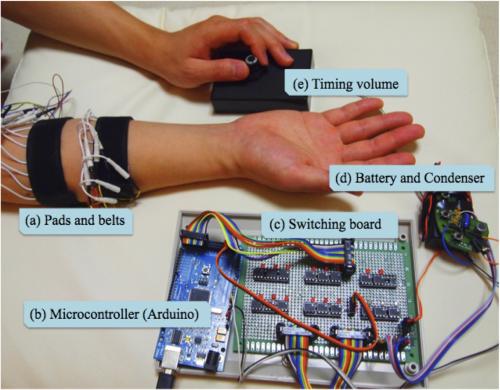
Image: Interfaculty Initiative in Information Studies, The University of Tokyo
In an interesting meshing of robotics and prosthetics development, Japanese researchers from Tokyo University working in conjunction with Sony Corporation, have created an external forearm device capable of causing independent finger and wrist movement. Introduced on the Rekimoto Lab website, the PossessedHand as it’s called can be strapped to the wrist like a blood pressure cuff and fine tuned to the individual wearing it. The PossessedHand sends small doses of electricity to the muscles in the forearm that control movement, and can be "taught" to send preprogrammed signals that replicate the movements of normal wrist and finger movements, such as plucking the strings of a musical instrument.
Though the signals sent are too weak to actually cause string plucking, they are apparently strong enough to cause the user to understand which finger is supposed to be moved, thus, the device might be construed to be more of a learning device than an actual guitar accessory.
Currently devices that do roughly the same thing are done with electrodes inserted into the skin, or work via gloves worn over the hand, both rather cludgy and perhaps somewhat painful. This new approach in contrast, is said to feel more like a gentle hand massage.
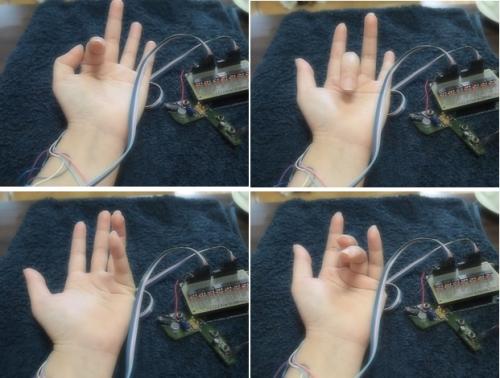
Image: Interfaculty Initiative in Information Studies, The University of Tokyo
Though the original purpose of the PossessedHand seems to be as an aid to help people learn to play musical instruments, something that has inspired a bit of criticism from the musical community due to the fact that nothing is actually learned when using the device; the hand basically becomes an external part of the instrument, while the brain remains passive; it seems clear the device could be used in multiple other ways. For example, it could be used by hearing people to assist in speaking with deaf sign-language users, or to help people type who have never learned how, or perhaps more importantly to help paralyzed people or those suffering from a stroke.

Interfaculty Initiative in Information Studies, The University of Tokyo
In these instances it’s not always imperative that the user actually learn anything new, just that they are able to communicate when they want to. If the programming of the device could be made to work in real time in other ways, by the user, then its value would greatly increase. For example if a person could speak out loud into a microphone and those words could then be captured and translated to sign-language and transferred directly to their fingers, deaf people would instantly be able to communicate with anyone they meet who is willing to wear the cuff.
-----
ASUS Eee Pad Transformer 2 Launch In October
Via TechTree
-----
ASUS is a well-known Taiwanese computer components manufacturer. The company stepped into the tablet industry a couple of years ago. The ASUS Eee Pad Transformer is the company's latest Honeycomb tablet with a unique form factor. This tablet comes with a keyboard (purchased separately), which transforms it into a mini laptop or netbook when docked to the tablet. The tablet hasn't seen the wider market yet, with countries like India still awaiting the launch of the tablet. Now it seems like the company is already planning a successor to the tablet powered by the NVIDIA Tegra 3 CPU, and apparently running Android Ice Cream Sandwich. The tablet could be launched in October or November this year. Previous rumours suggested that ASUS was planning to have a successor to the Eee Pad Transformer running on the Windows 8 platform, but this new rumour seems more likely. Also, the fact that this news comes from a supplier chain of ASUS in Taiwan, makes it seem much more plausible.
The ASUS Eee Pad Transformer is a regular Honeycomb tablet with a 10.1" display. It stands out in the crowd of tablets because it comes with a keyboard (which can be bought separately), literally transforming it into a netbook. A similar feature is available with the Motorola XOOM, allowing it to be paired with a Bluetooth wireless keyboard. The Acer Iconia Tab is already available in India, and with the XOOM, Galaxy Tab 10.1 and Eee Pad Transformer launching soon, the tablet market in India could heat up in no time.
The Eee Pad Transformer runs on a 1 GHz dual core NVIDIA Tegra 2 CPU, which is seen in most Honeycomb tablets. The Tegra 3 processor codenamed Kal El is a quad core CPU capable of running each core at up to 1.5 GHz. The Kal El is said to be up to 5 times faster than the Tegra 2 processor, so we can only imagine the snappiness of that beast.
-----
Personal comment: This kind of "hybrid" hardware demonstrastes perfectly how "new" the so-called "concept" of tablet is! Starting from a laptop, removing the keyboard and installing a lightweight OS... in order to install back a keyboard less than two years later. Now, thanks to all hardware constructor's tablets and hybrid models, one can easily think and admit that any laptop can be "transformed" to a tablet and reverse, and, as end-user, we may now request this kind of feature for all laptops without any power of functionality drawback... making mobile computing hardware converging again to one global solution valuable for any kind of use.
Friday, June 24. 2011
Five fingers mouse
Via TechnoLookers
-----
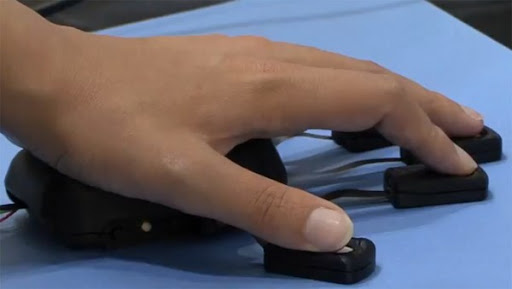
Amenbo Mouse
If you want to feel different sensations are not just a classic mouse, which is pretty cool, his name is Amenbo Mouse, a mouse equipped with a touch of beauty to five fingers with a shape similar to a human hand. A study conducted by the Japan Twin Research & Development Co. has successfully developed a mouse is truly revolutionary.
And now, they’ve officially showcased his creations mouse with Amenbo name, a new input device is a mouse that will not waste the function of one finger but will give a touch sensor for the fifth finger. Each finger will get the mouse pad itself with sensors, which are all connected to a single base with a flexible material that allow movement. The device can detect pressure and finger movements, and is ideal for many uses.
“We put sensors on each fingertip mouse, and can enter the coordinates for each finger as well as downward pressure from each finger means actual hand movements are being fed into a PC .. For example, is allow the PC to receive data for the various needs of the toes “said the Japan Twin Research & Development Co..
One example application for this system is to manipulate the data in 3D CAD. Sometimes in order to manipulate the data in 3D CAD or rather need to use a 3D mouse and normal mouse using both hands, but in this Amenbo mouse system functions can be combined and operated with one hand, and much more usefulness depends on the user’s needs.
As we can see from the demo video below, mouse Amenbo able to perform with good movement to move the 3D object, the mouse Amenbo own work through connection to a computer USB port connection, unfortunately for more complete information including the marketing has not been disclosed.
Wednesday, June 22. 2011
Japanese researchers create self-propelled endoscope capsule
Via Slashgear
-----
The endoscope has been the go to tool for doctors that need to look inside the digestive tract of a patient since the 1980?s. These things are generally long, black cables that are forced through the mouth of up the bum of people when the doctors need to check for things like colon cancer or stomach issues. In 2008, we talked about a new development in endoscope tools that placed the camera into a small pill shaped capsule that the person swallowed to get a look at their innards.

The problem with that camera capsule was that it could only follow along and take photos inside the body using the muscle contractions of the patient’s body. Some Japanese researchers have taken that endoscope capsule to the next level and attached a small propulsion system to it that allows the camera to swim through the digestive tract. The new capsule has what appears to be a flagella type mechanism on the back that uses a magnetic propulsion system.
The doctor is able to control the capsule using a joystick to get it to take photos of whatever part of the digestive track is needed. The device has been nicknamed “mermaid” and it would have to feel strange moving around inside the body. It is certainly better than a four foot long tube crammed down your throat.
Friday, June 17. 2011
Kinect for Windows SDK beta released
Via slashgear
-----
Microsoft has released the Kinect for Windows SDK beta, as expected, allowing PC developers to use the motion-tracking accessory. A free 100MB download, the SDK offers support for the depth sensor, color camera and quad-microphone array, along with all the clever skeletal-tracking systems that Xbox 360 game developers have had access to.

There’s also integration with Windows’ speech recognition API. That potentially means developers will be able to use the microphone array – which can pinpoint which user is talking thanks to beam formation – to transcribe speech to text, open and control applications, and more.
Microsoft has thrown in plenty of technical documentation, samples, all the drivers you’ll need and support for C++, C#, or Visual Basic. This current iteration of the SDK is only for non-commercial purposes; Microsoft says it will be releasing a commercial version later on. You’ll obviously need a Kinect sensor, too, which currently costs around $140.
----
Tuesday, June 14. 2011
iTunes costs as much as $1.3B to run yearly
Via asymco
-----
The iTunes store continues to grow. The data that Apple published in the last event included the following:
- 15 Billion iTunes song downloads
- 130 million book downloads
- 14 billion app downloads
- $2.5 billion paid to developers
- 225 million accounts
- 425k apps
- 90k iPad apps
- 100k game and entertainment titles
- 50 million game center accounts
As this data is added to the existing data and cross-referenced additional insight into the economics of iTunes is emerging.
Since we know something about the average price of songs and apps, and we know the split between developers and Apple (and roughly between music labels and Apple) we can get a rough estimate of the amount Apple retains to run its store.
The following chart shows iTunes “content margin” by month. This margin is what Apple “keeps” after paying content owners but before paying for other costs like payment processing and delivery/fulfillment which should be accounted as variable costs. Strictly speaking this margin is not “gross margin”.

If we add the content margins from music and apps and assume the store runs at break even we can get an idea of what it costs to operate the store. The latest number is $113 million per month (from a total income of $313 million/mo.). It implies over $1.3 billion per year.
Much of that cost does go into serving the content (traffic and payment processing). Some of it goes to curation and support. But it’s very likely that there is much left over to be invested in capacity increases.
I would like to hear alternative opinions, but my guess is that much of the capex that went into the new data centers Apple built came from the iTunes operating margin.
Quicksearch
Popular Entries
- The great Ars Android interface shootout (130700)
- Norton cyber crime study offers striking revenue loss statistics (100992)
- MeCam $49 flying camera concept follows you around, streams video to your phone (99708)
- Norton cyber crime study offers striking revenue loss statistics (57221)
- The PC inside your phone: A guide to the system-on-a-chip (56998)
Categories
Show tagged entries
Syndicate This Blog
Calendar
|
|
December '25 | |||||
| Mon | Tue | Wed | Thu | Fri | Sat | Sun |
| 1 | 2 | 3 | 4 | 5 | 6 | 7 |
| 8 | 9 | 10 | 11 | 12 | 13 | 14 |
| 15 | 16 | 17 | 18 | 19 | 20 | 21 |
| 22 | 23 | 24 | 25 | 26 | 27 | 28 |
| 29 | 30 | 31 | ||||

